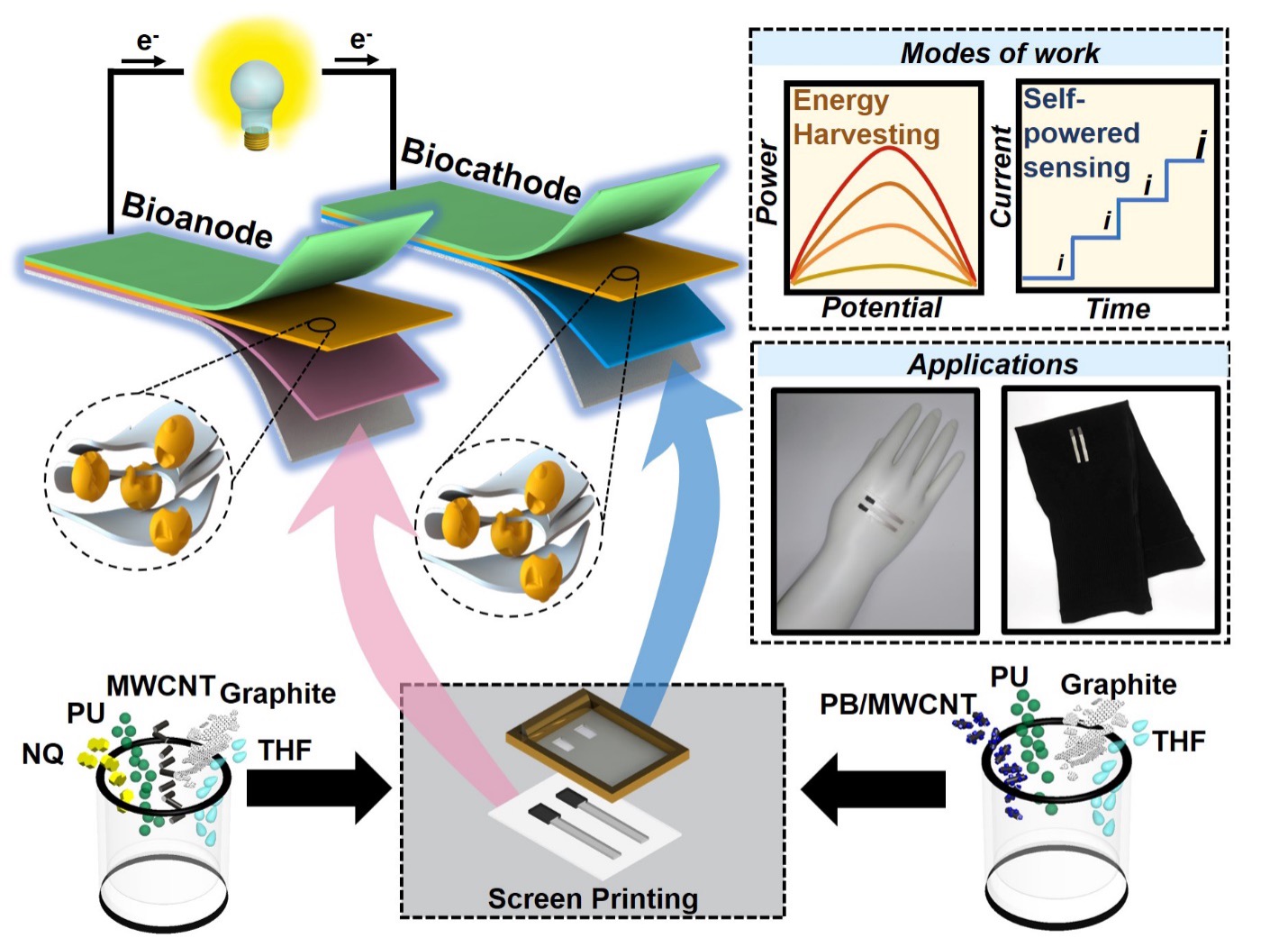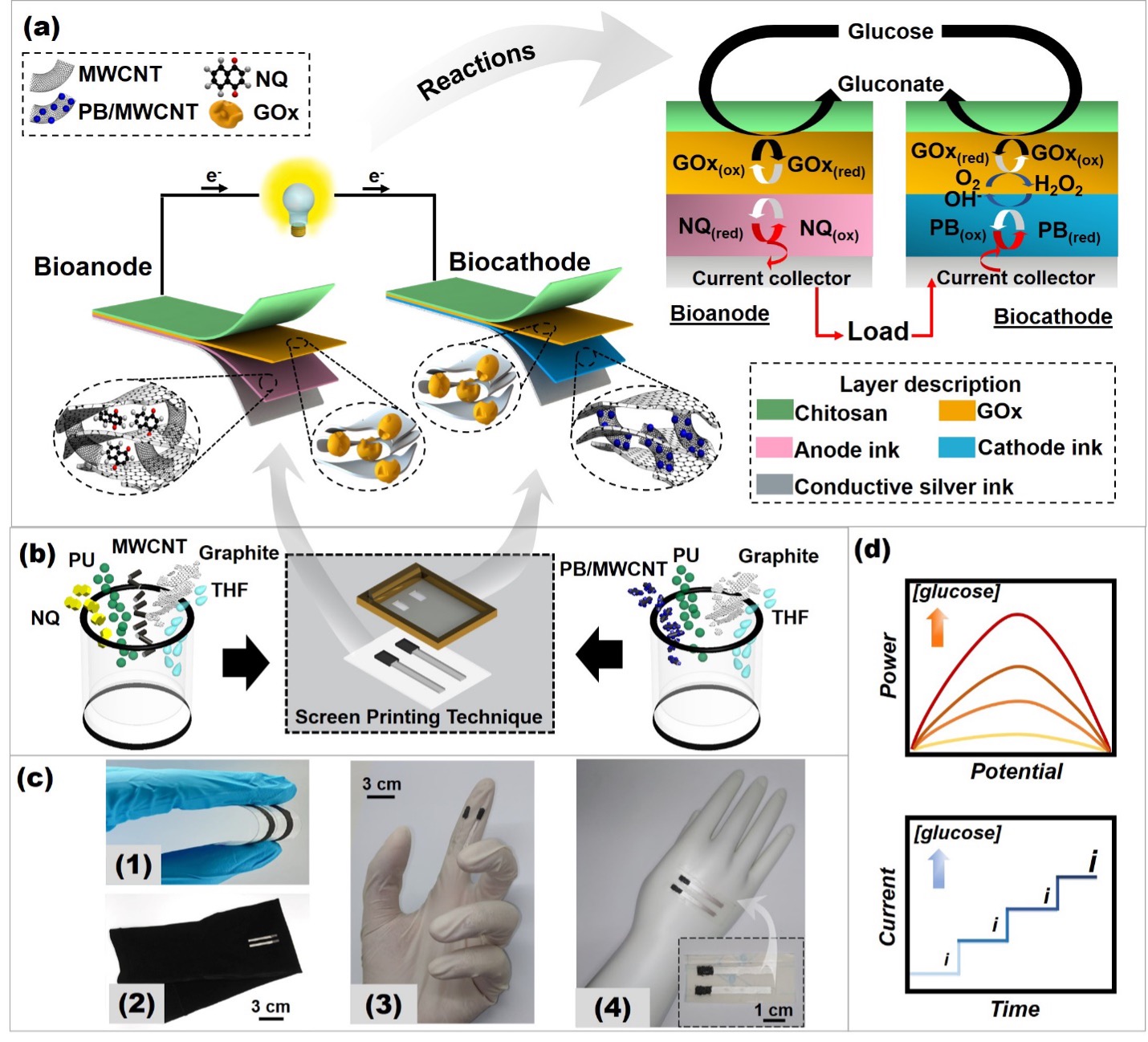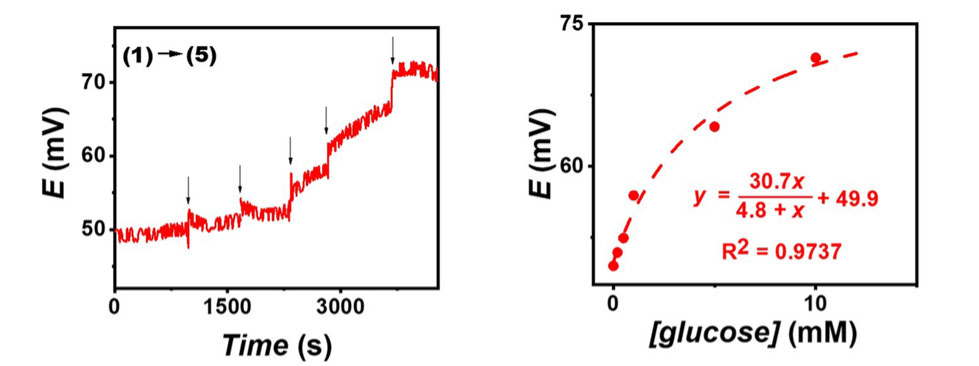| Apr 13, 2023 | |
Single-enzyme breakthrough powers flexible biofuel cells |
|
| (Nanowerk Spotlight) Enzymatic biofuel cells (BFCs) have long held the promise of creating efficient, wearable, and environmentally friendly devices, but their potential has been hampered by the complexities and high costs associated with using multiple enzymes in their design. A new, groundbreaking study published in Nano-Micro Letters ("Screen-Printable Functional Nanomaterials for Flexible and Wearable Single-Enzyme-Based Energy-Harvesting and Self-Powered Biosensing Devices") manages to overcome these challenges and develop a more practical and cost-effective solution for real-world applications. | |
| By adopting a single-enzyme approach, scientists at Prince of Songkla University in Thailand, have unlocked a new era in BFC technology, where one device serves a dual purpose: harvesting electricity and providing an analytical signal for glucose detection, all powered by a single enzyme, glucose oxidase, on both the anode and cathode. This innovative approach not only simplifies the design of BFCs but also revolutionizes their use in various applications, such as healthcare, environmental monitoring, and smart fabrics. | |
 |
|
| Graphical abstract of the work. (Creative Commons Attribution 4.0 International License) | |
| "We have harnessed the power of glucose oxidase (GOx), a biocatalyst that is much cheaper than other enzymes commonly used in BFCs," Itthipon Jeerapan, an assistant professor and a research principal investigator at Prince of Songkla University, and the paper's corresponding author, tells Nanowerk. "The cost of GOx amounts to a mere 0.4 USD per 100 units, whereas other enzymes such as laccase and bilirubin oxidase can cost anywhere from 30 to 700 USD per 100 units. This makes our new technology not only more efficient but also more accessible and affordable." | |
| The outcome of this research is a flexible, printed BFC-based energy harvester and self-powered biosensor with outstanding performance and stability. The device yields an open circuit voltage of 0.45 V and a maximum power density of 266 µW/cm2. It also detects glucose concentrations up to 10 mM and can withstand multiple mechanical deformations. The researchers have even demonstrated real-time data collection with a portable wireless device that allows for seamless communication between sensor units and portable devices, such as smartphones. | |
| This single-enzyme BFC technology provides glucose measurements in the range of 0-10 mM and is unaffected by common interfering substances. These features make it an ideal solution for on-body electronics, self-sustainable applications, and smart fabrics. | |
| Jeerapan and his team have also developed screen-printable functional nanomaterial-based inks that enable the fabrication of highly flexible electrodes using a screen-printing technique. These electrodes can be integrated with a wide range of wearables and soft bioelectronics, such as biosensors and energy-harvesting devices. The biofuel cell reactions are driven by glucose, and both the bioanode and biocathode employ the same biocatalyst (glucose oxidase) for their respective reactions. The biocathode utilizes printed Prussian blue-based nanomaterials as an electrocatalyst for hydrogen peroxide reduction, resulting in favorable biocatalytic energy-conversion performances. | |
 |
|
| The conceptual presentation of a screen-printed and flexible single-enzyme-based system for harvesting energy from glucose and self-powered sensing glucose. a The components of a screen-printed glucose BFC along with redox reactions occurring on the bioanode and the biocathode. b Preparation of the screen-printable inks for the anode and the cathode. c Photographs of a screen-printed glucose BFC on (1) poly(ethylene terephthalate) (PET), (2) a stretchable textile (arm sleeve), (3) a glove (fingertip), and (4) a stretchable epidermal tattoo attached to a hand model. d The working operation of a screen-printed glucose BFC on (top and bottom) energy-harvesting and self-powered sensing modes. (Creative Commons Attribution 4.0 International License) | |
| This innovative technology has significant implications and applications, especially in the realm of healthcare. It paves the way for the development of noninvasive and energy-sustaining glucose monitoring devices that can be used for real-world health status diagnostics. The ability to print functional nanomaterials on flexible substrates can enable the fabrication of low-cost and scalable wearable devices for energy harvesting and biosensing applications, leading to self-powered wearable devices that can monitor various physiological parameters in real-time. | |
| Furthermore, the use of a single-enzyme-based biofuel cell in this work provides a simpler and more efficient method for energy conversion compared to traditional enzymatic biofuel cells that use multiple enzymes. This could pave the way for the development of more efficient and reliable energy harvesting devices that can operate using a single enzyme. | |
| As the field of wearable electronics and biosensors continues to evolve, future research will focus on exploring different nanomaterials and composites to enhance device efficiency and stability, developing integrated systems for simultaneous monitoring of multiple biomarkers, and miniaturizing the devices while enabling remote monitoring through wireless communication systems. Challenges remain, such as improving long-term stability and durability in harsh environments, reducing device costs while maintaining performance and reliability, and establishing standardized protocols for reproducibility and comparability of results across research groups. | |
| This exciting breakthrough in BFC technology marks the beginning of a new era in on-body electronics, smart fabrics, and self-sustainable applications. The development of screen-printable functional nanomaterials for flexible and wearable single-enzyme-based energy-harvesting and self-powered biosensing devices has the potential to revolutionize how we monitor our health and well-being. | |
 |
|
| (Left) The self-generated voltage output obtained from a screen-printed glucose BFC and a wireless voltmeter, with no applied potential upon increasing the glucose concentrations (0, 0.2, 0.5, 1, 5 and 10 mM). (Right) The corresponding calibration plot of self-generated voltage output and glucose concentrations. (Creative Commons Attribution 4.0 International License) | |
| "With the ability to monitor glucose concentration in real-time, this idea could make a significant impact on lives, such as of those with diabetes, since the relationship between electrical output and glucose level in sweat could be meaningful,"" Jeerapan points out. "Early detection and consistent monitoring could help individuals better manage their conditions and potentially avoid complications." | |
| In addition to healthcare applications, this technology could also play a vital role in environmental monitoring and medical diagnostics. The flexible and self-powered biosensors are highly resilient to mechanical deformations, making them suitable for integration with a wide range of wearables and soft bioelectronics. | |
|
As the world becomes increasingly connected and reliant on technology, the demand for flexible, wearable, and self-sustainable devices will only continue to grow. This new approach to BFC technology is a significant step towards meeting that demand while also addressing the challenges of cost, efficiency, and sustainability.
|
|
 By
Michael
Berger
– Michael is author of three books by the Royal Society of Chemistry:
Nano-Society: Pushing the Boundaries of Technology,
Nanotechnology: The Future is Tiny, and
Nanoengineering: The Skills and Tools Making Technology Invisible
Copyright ©
Nanowerk LLC
By
Michael
Berger
– Michael is author of three books by the Royal Society of Chemistry:
Nano-Society: Pushing the Boundaries of Technology,
Nanotechnology: The Future is Tiny, and
Nanoengineering: The Skills and Tools Making Technology Invisible
Copyright ©
Nanowerk LLC
|
|
|
Become a Spotlight guest author! Join our large and growing group of guest contributors. Have you just published a scientific paper or have other exciting developments to share with the nanotechnology community? Here is how to publish on nanowerk.com. |
|
